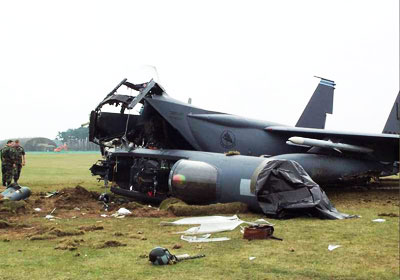
F-15 Eagle - $$4.50
The McDonnell Douglas (now Boeing) F-15 Eagle is a twin-engine, all-weather tactical fighter designed to gain and maintain air superiority in aerial combat. It was developed for the United States Air Force, and first flew in July 1972. It is one of the most recognized fighters of the modern day.
McDonnell Douglas F-15 Eagle
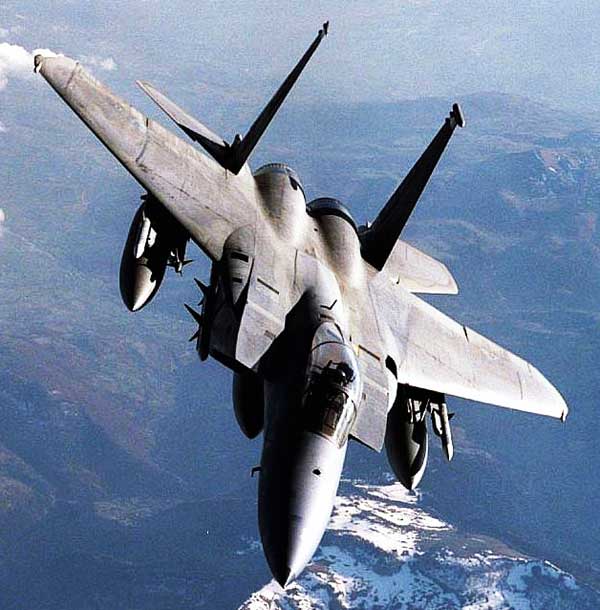
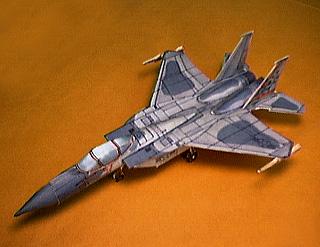
First flown in 1972, this multi-role fighter has established itself as one of the best aircraft in its class in the world. Max speed is over Mach 2.5!!
Shown here is a made up Cyber Model printed by an Epson 800 Ink jet printer.
Because of the recent state of "Heightened Security" two types of photo ID may be required to buy this model..
"Great design on this model." - Mike Langford
F-15 Eagle
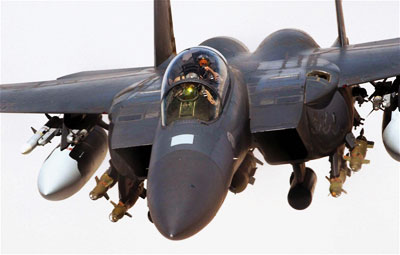
Many Western observers consider the F-15 probably the best fighter in the world. In 1967 the arrival of the Russian MiG-23 and the MiG-25 ed the US Air Force to reconsider the belief that had held sway for a decade: that fighters should be designed to fulfill a variety of different roles. What we now need they said "is a true air superiority fighter."
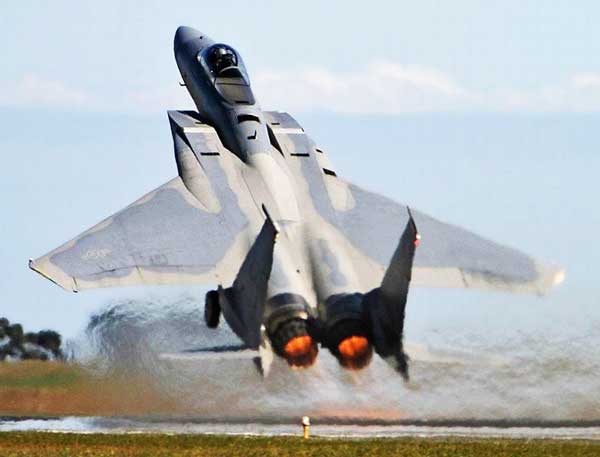
After the usual intense competition, McDonnell was chosen in 1969 to produce the F15 Eagle bringing true dogfight superiority back to the West.
Nothing is ever simple in aviation and the F- 15 Eagle, despite its acclaim as a super air-to-air fighter, performs excellently in a variety of other roles, as demonstrated by its ability to deliver no less than 23,600lb of offensive weapons. Because the F- 15 was designed for one role only,it has an enormous fixed wing. At relatively low speeds, rolling man oeuvres are effected by aileron; as the F- 15 reaches supersonic speed these man oeuvres are initiated by a combination of differential taileron and twin-rudder controls.
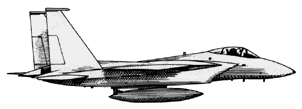 The two big turbofans are fed by inlets which are not only
fully variable according to Mach number but which also tilt downwards
in nose-high flight at low speeds. The massive power output is
at sea level considerably more than the F- I 15's clean gross weight,
and is a major factor in the F- 15s amazing rate of climb and
outstanding performance in the vertical plane. The Pratt &
Whitney Fl 00 was designed especially for the Eagle, and colossal
funding was provided by the US Air Force. The engine was not without
its problems, however, and for many years has suffered from 'stall
stagnation' another problems. Competition from General Electric
has spurred the new Fl00-220 version which is designed to fly
4000 combat missions without overhaul.
The two big turbofans are fed by inlets which are not only
fully variable according to Mach number but which also tilt downwards
in nose-high flight at low speeds. The massive power output is
at sea level considerably more than the F- I 15's clean gross weight,
and is a major factor in the F- 15s amazing rate of climb and
outstanding performance in the vertical plane. The Pratt &
Whitney Fl 00 was designed especially for the Eagle, and colossal
funding was provided by the US Air Force. The engine was not without
its problems, however, and for many years has suffered from 'stall
stagnation' another problems. Competition from General Electric
has spurred the new Fl00-220 version which is designed to fly
4000 combat missions without overhaul.
An important element of the design was to be the inclusion of a special 25mm Gating-type gun which would use caseless ammunition. However, this was abandoned at an early stage in the project, and replaced by the well-proven 20mm General Electric M6 I, housed in the right wing root, with ammunition in a tank inboard of the engine duct. When the gun is fired, the rudders are automatically applied just enough to counteract the off-center recoil.
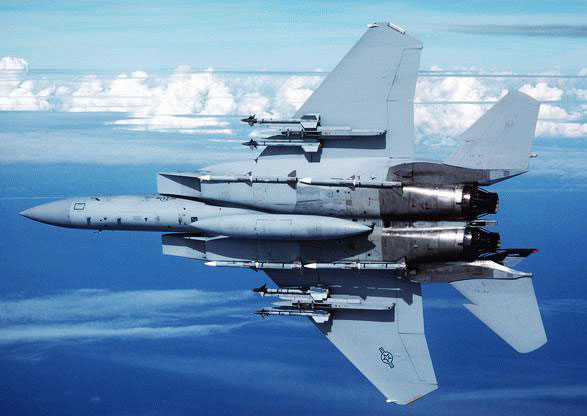
Visibility is excellent with full 3600 view through the bubble canopy. The Hughes APG-63 (now upgraded to APG-70) radar gives the pilot plenty of warning and is capable of detecting airborne and surface targets at long range with marvelous clarity, Initially this information is supplied on a head-down display mounted on the instrument panel. At closer ranges the radar picture is presented on the HUD (head-up display), with all radar controls on the stick and throttles, which enable the pilot to control the radar and all weapons while maneuvering. He can select the weaponry using a throttle-mounted switch; as he does this, the radar automatically switches to the correct mode.
Normal missile armament is four AIM-7 Sparrows plus four AIM-9 Sidewinder missiles. The Sidewinder is, of course, well-proven, but the medium-range Sparrow was shown to be somewhat unreliable during the Vietnam war, That earlier AIM-7E version has now been replaced by a longer-range AIM-7L, with the mono pulse-guided AIM7M version also entering service, This will be even more resistant to electronic countermeasures. The Sparrow's greatest 'scalp' to date came when an Israeli F-15 shot down a Syrian MiG-25 on 29 July 1980.
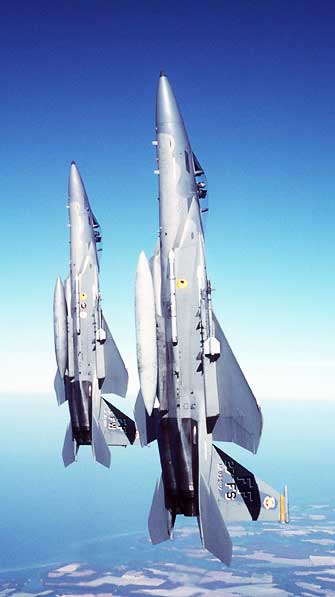 The F- 15C has an internal fuel capacity of no less than 13,455lb.
This can of course, be augmented by external tanks and air-to-air
refueling, The F- 15C can also carry two FAST (fuel and sensor,
tactical) conformal tanks along the sides of the fuselage which
house an extra 9725 lb of fuel, and the total fuel capacity for
ferry purposes is an amazing 35,075 lb - as heavy as three fully
loaded P-51s!
The F- 15C has an internal fuel capacity of no less than 13,455lb.
This can of course, be augmented by external tanks and air-to-air
refueling, The F- 15C can also carry two FAST (fuel and sensor,
tactical) conformal tanks along the sides of the fuselage which
house an extra 9725 lb of fuel, and the total fuel capacity for
ferry purposes is an amazing 35,075 lb - as heavy as three fully
loaded P-51s!
The initial order for the Eagle was 729, but this number has risen to 1488, of which over 1000 have been delivered. The first versions were the F- 15A and tandem dual-control F- 15B, but in 1979 these gave way to the F- 15C and F- I SD with many improvements. The USAF now plans also to buy 392 F- 15E dual-role fighters, with APG-70 high resolution radar, a new computer and programmable armament control system, with avionics managed from the rear seat, and colossal capability in the attack mission. The F- 15E will be able to operate at weights up to 81,000 lb, about twice as much as the wartime B-17 Fortress!
When one looks at the new F- 15E it seems unbelievable that such a modest-sized conventional aircraft can have such capability. The main landing gears each have a single leg and a single wheel with a small-section tire inflated to very high pressure. To take off at a speed exceeding 200mph at a weight in excess of 80,000 lb seems incredible, until one realizes that this rests squarely on great engine power, superb structural materials and a great length of the best and smoothest concrete. On the other side of the Iron Curtain they have never stopped building aircraft which, on paper, are less impressive, with less weight and giant low-pressure tires which often cause bulges in the aircraft when they are retracted. The difference lies in the fact that the Soviet warplanes do not need airfields, and in wartime this could be the difference between survival and destruction.
To date, no other aircraft in the Western world has been able to match the F- 15's all-round performance. Its combination of excellent high power-to-weight ratio, light wing-loading and massive precision strike capability make it a difficult act to follow.
McDonnell Douglass F-15 design was declared the winner of a USAF competition over proposals from Fairchild Hiller and North American Rockwell, in December 1969 for a new air superiority fighter to counter the ascendancy of Soviet fighters in this category, particularly the MiG-25. The Eagle is a single-seat, twin-turbofan all-weather fighter, armed with a built-in rapid-firing gun (initially the 20mm M6 I-Al, with 1.000 rounds) and tour Sparrow and four Sidewinder AAMs.
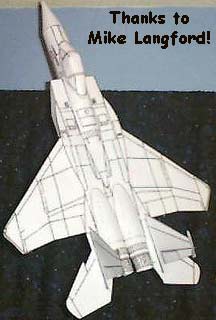 It has a secondary attack capability and a radar
capable of detecting low-flying targets, but the basic roles are
air-to-air interception, fighter sweep, escort and combat air
patrol. Particular emphasis has been placed on the dog-fighting
aspects of maneuverability and acceleration - an area in which
the gap between US and the latest Soviet fighters had widened
appreciably. Initial funding covered the production of 20 development
aircraft (including two 2-seaters, and the first of these (71-0280)
flew on 27 July 1972, followed by the first 2-seat TF-15 on 7
July 1973, which has a similar combat capability, encompassing
reconnaissance and attack roles, and was thus redesignated F-15B.
It has a secondary attack capability and a radar
capable of detecting low-flying targets, but the basic roles are
air-to-air interception, fighter sweep, escort and combat air
patrol. Particular emphasis has been placed on the dog-fighting
aspects of maneuverability and acceleration - an area in which
the gap between US and the latest Soviet fighters had widened
appreciably. Initial funding covered the production of 20 development
aircraft (including two 2-seaters, and the first of these (71-0280)
flew on 27 July 1972, followed by the first 2-seat TF-15 on 7
July 1973, which has a similar combat capability, encompassing
reconnaissance and attack roles, and was thus redesignated F-15B.
The first Eagles were delivered to USA? TAC in November 1974. The USAF plans an eventual purchase of 749; about two thirds of these had been delivered by 1981. Those delivered since mid-1979 are F-15Cs (single-seat) and F-15Ds (2 seat) with extra internal fuel, plus provision for FAST (Fuel And Sensor Tactical) Packs - pallets for fuel and reconnaissance/ECM gear, which fit flush against the intake trunks. Five weapons stations on the standard F-15 permit carriage of up to 16,000 lb of ordnance; additional weapons can be attached to the FAST packs.
The Strike Eagle 2-seat attack version has advanced nay/attack radar, Pave Tack night/all-weather targeting pods, with infra-red tracking and laser-spot designation, and up to 24,000 lb of weapons. USA? Eagles were serving in 1981 with the 1st, 33rd and 49th TFW, and two training wings, in the USA; the 36th TrW and 32nd TFS lit Europe, and part of the 18th TrW in Okinawa. Foreign customers include Israel (25), japan (100) and Saudi Arabia (60). Ironically, the light-weight, low-cost', highly manoeuvrable, Mark 2 General Dynamics F-IS air superiority fighter was developed to counter the F-15A's sophistication.
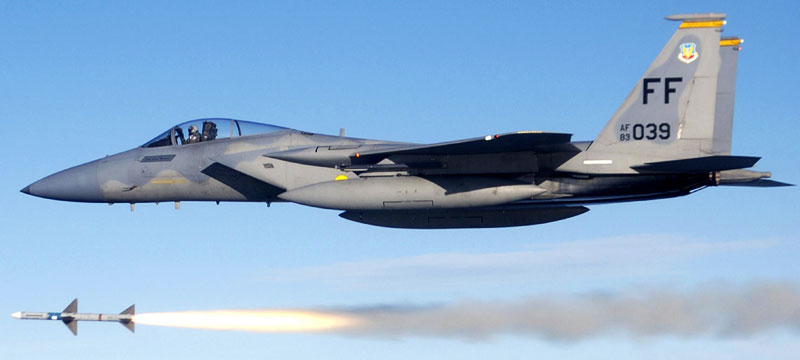
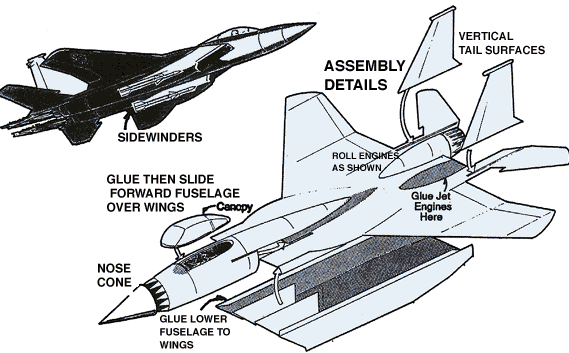
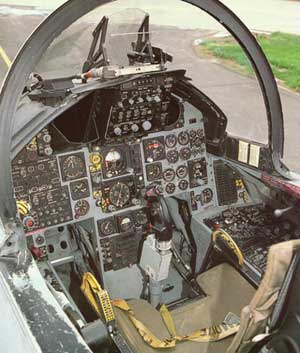 |
F-15 Eagle Cockpit. |
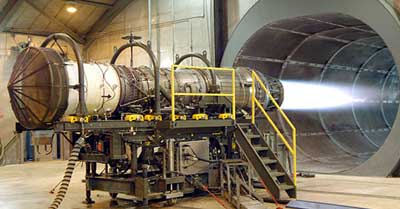 |
F-15 Eagle engine test fire. |
McDonnell Douglas F-15 Eagle Specifications
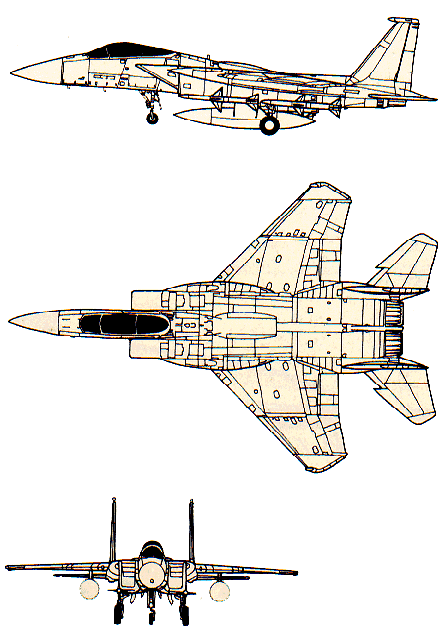 |
Length: 63 ft 9 in Armament |
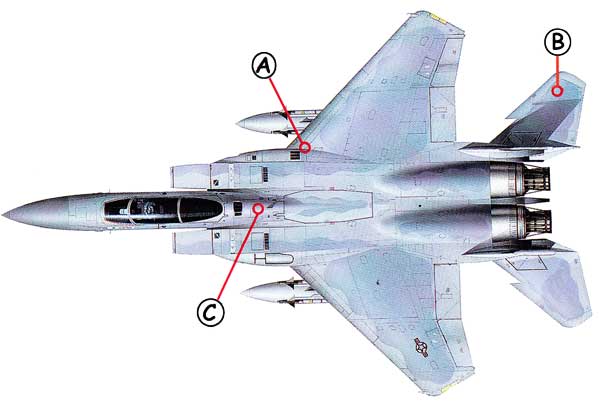 |
||
| A: The M61 Vulcan cannon is mounted in the starboard wing root. The port wing root houses the refueling receptacle for USAF's "flying boom" refueling system. | B: Twin tailfins were used in the F-15 to give good control in slow-speed dogfights. The tailplane was built with a dogtooth to cure flutter problems. | C: The F-15 has a very large speed brake mounted on the top of the center fuselage. This design feature also appeared on the Su-27 after early trials with other layouts. |
 |
||
| A: The F-15C's cockpit has multi- function display screens in place of conventional instruments. | B: The F-15 design brief called for good dogfight performance, so the view from the canopy was given priority. It is better than the more recent MiG 29 "Fulcrum." | C: The fuselage of the F- 15 is immensely strong, with a large number of composite. titanium and steel components. The airframe is stressed to withstand nine times the force of gravity. |
| D: The large APG-63 radar has been replaced in the F-15C by the improved APG-70. This radar has very long range, good lookdown/ shootdown performance and improved reliability. | E: The Tracor AN/ALE-45 chaff and flare dispenser system, also fitted to the F-15E, is located just behind the nosewheel doors. | F: The twin Pratt & Whitney F 100 engines were initially troublesome, especially when afterburner was selected. Their tremendous power-to-weight ratio was unmatched for many years. |
